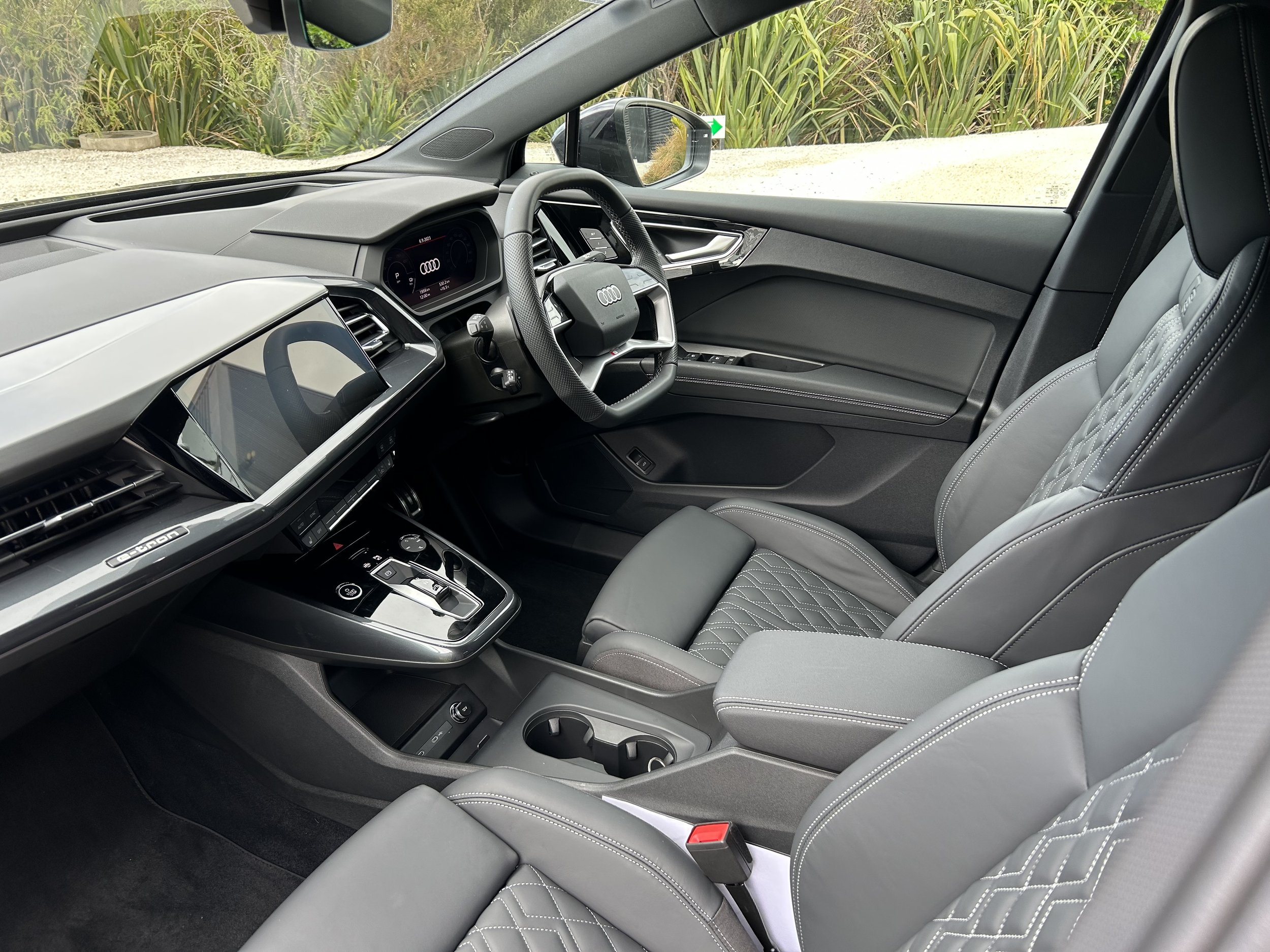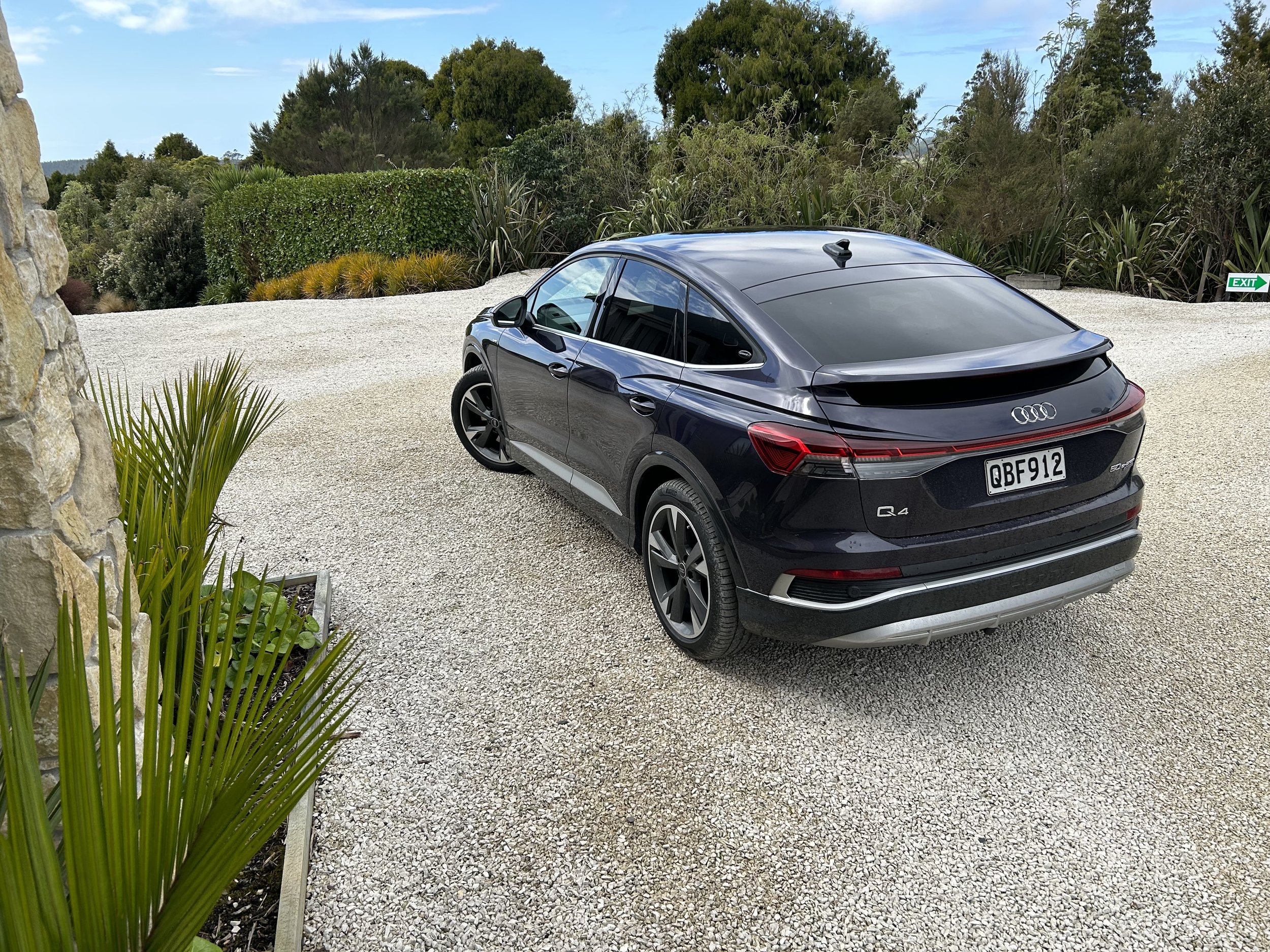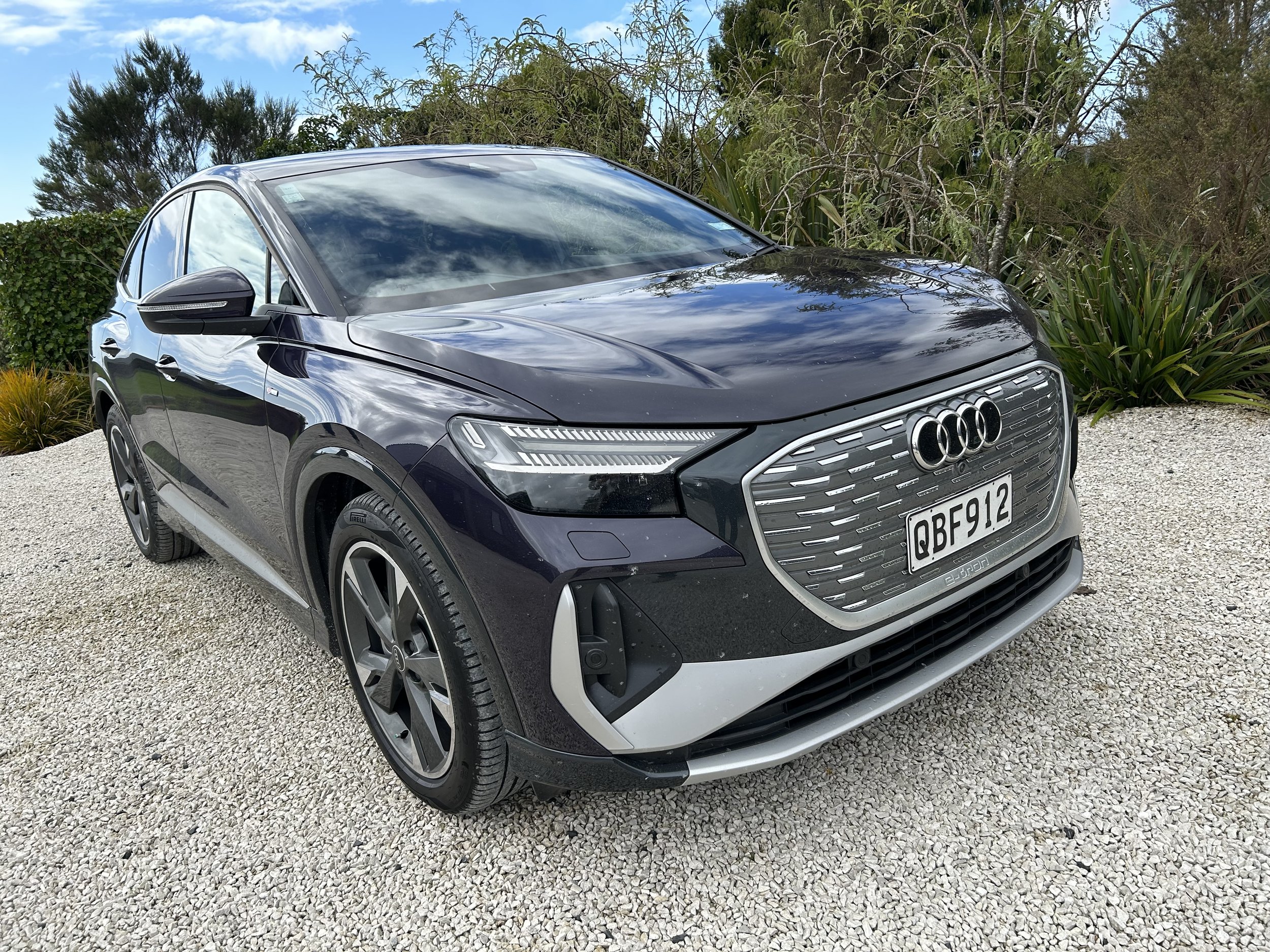Audi Q4 e-tron first drive review: Put a ring on it
/The most important member of Ingolstadt’s electric car family arrives. Like they always say, ‘better late than never.’
REASONS why the car most vital to Audi’s electric push has taken so long to get here are well known; what’ll relieve those who’ve held on is finding it has stood the test of that prolonged wait time.
Ability to sit pretty as the years roll by is an Audi design intrinsic that serves the Q4 e-tron well.
Better than might have been expected, given the squared-up sports utility and alternate sleeker-roofed Sporthatch stylings are, if not quite conventional in all ways, nonetheless a bit more ‘conventional Audi’ in ambience than other incumbent e-trons.
Being the first e-tron to base on the Volkswagen Group's MEB electric vehicle platform influences why this is so. The one-for-all approach of course means it not only uses the same running gear as the Skoda Enyaq and VW ID.4 but also demands all three have the same hardpoints, which in turn unavoidably means a degree of dimensional commonality. But that’s hardly a new thing to handle. So many VW Group cars through the ages have been this way.
What’s also apparent from an in-the-metal meeting is that, while the Q4 is certainly attractive and eye-catching, it is also a touch less a flight of fancy than the e-tron GT or next year’s Q6. That’s reflection of a marketing realisation. Whereas every other e-tron creates its own future-first niche, the Q4’s naming convention reminds it has to sit, at least for an intermediate period, in an internal combustion-engine dominant corner, with the Q3 (which it roughly apes in physically size) and Q5, which it at least matches for internal dimension. That asks it to be tomorrow’s world futuristic, yet today’s world familiar. So went the school of thought when the design was signed off.
Which was? Well, that’s the point. This cornerstone of Audi’s electrification plans revealed in its primary, SUV shape, at the last Geneva motor show. In 2019. The identical save for minor detail change production model came out in 2020. The coupe revealed, and entered production, in 2021. A while ago.
Yet if you’re looking for signs of staleness? Good luck. Naff infotainment graphics; the old-school cruise control operability? Sure, you can point those out as signs of age. But only if accepting that all other Audis, including every other e-tron, also suffers the same. In broader sense, there’s just nothing to remind of lost time. It’s as if it had been kept cryogenically. Modern then remains modern now.
Really, the bigger debate for those in mind for MEB will be the usual thing that always crops up with cross-pollinating VW Group product. Is Audi premium-ness worth the extra dollars?
On strength of this first drive experience, it’s a point that might sustain with the entry $99,990 Q4 40 e-tron Advance, which just presents as ID and Enyaq do for nearly $20,000 less; with a rear-drive single motor format. Common outputs of 150kW/310Nm, much muchness in respect to performance attribute (160kmh top speed, 0-100km in 8.5 seconds) and WLTP-attested range (up to 528km with Sportback, a touch less for the less wind-cheating SUV).
Point of difference comes, of course, with the top 50 e-tron S-Line, that in return for its $126,990 tag delivers more luxury, more tech and more motors. To earn the vaunted quattro badge, it doubles up.
Accordingly, feeding off the same-sized 77kWh net (82kWh gross) battery as every other MEB are dual motors, one on each axle for combined outputs of 220kW and 460Nm. Zero to 100kmh falls to 6.2s and, while top speed is “for reasons of efficiency” restricted to 180kmh, it is a markedly more electric offer; one of a kind until the dual motor ID.4 GTX comes in mid-2024.
What difference does quattro make? All the difference you would expect. It’s not the same in electric than it is behind a internal combustion engine, all the same. With petrol quattros, the system is much more active; here’s it’s more on a needs-must basis.
In electric, feeding two motors continuously would be wasteful on energy drain. So the e-tron quattro is engineered so that in normal driving, the car is wholly propelled by its rear motor. That minimises impact on range, though it does degrade nonetheless, to 511kms WLTP.
The front motor will enact in slippery driving conditions or when cornering hard. From this first experience the sensitivity is totally sorted; the slightest excuse and it is involving, boots and all. And when it does engage you’re left in no doubt about its influence.
On such occasions, the Q4 Quattro transforms into a totally different beast to the Enyaq and ID.4. There are times when the front motor’s pull is a little too clearly felt through your wrists, but commensurately there’s a huge lift in traction and perception of it having the cojones to carry its thrust through corners with a high level of competence.
This isn’t purely the impact of the reapportioning of the drive. Like all EVs, the Q4 has a decent kilo count, but the weight is all centralised and low-slung. That factor, and Audi meting the car with very good performance rubber, combine to make it as hugely serious about challenging fundamentals of physics as any ICE performance Audi. Grip and go is to verge of brutality, in fact. There will eventually have to be an RS edition and you wonder how much more bonkers it will be.
That kind of work out provides reminder that, as much as you might think all MEB cars are set to be alike in driving character, reality is they are not.
I’ve already found the Enyaq to be the quiet, considered member f the family. ID, on first impression, seems more alert but also tempered. Cupra, which is more a cousin through being basically an ID.3 that’s taken Spanish lessons, is different again; a bit of a baby berserker.
Audi has also managed to put its own stamp on how it drives. Mainly it’s on the agility side, but there does seem to be trade-off in ride quality. It’s a car that seems especially sensitive to surfaces, no matter the drive mode setting. Stick to smooth tarmac and it’s refinement times 10. Coarse chip, though, is less friendly; the two cars I drove were jittery and thrummy on the worst sections. Not intolerably so, but enough to be irksome at times.
That’s a pity because, when on on decent surfaces German engineers would be more used to, it is highly refined. Even allowing for the fact that an electric powertrain is always quiet, it was exceptionally refined on the new motorway between Auckland to north of Warkworth.
There’s sense this is a product dedicated to the enthusiast. Audi determination to implement Q4 with 'progressive steering', which is Ingolstadt-speak for variable ratio, means the further away from straight ahead you turn the wheel, the quicker the steering becomes. It's subtle, but appreciated. Beyond that, the Q4 appears to deliver decent body control.
The quattro achieving 70 percent of early take-up is understandable. The 50-50 buy-in split between body shapes likewise. Choosing is a coin toss.
Even though it demands a new rear end, with a narrower rear window and lowered overall height, and adds $4000 to the list price, the Sportback doesn't look like a dramatic departure from the standard model.
A roofline that arcs its way to the rear of the car makes for a very different look but, aside from resulting in smaller rear side windows, interior space isn't really as compromised as you might think. Rear occupant room is okay and so is boot space.
The 535 litres of luggage space to the window line in five-seat mode is actually 15 litres more than in the standard car. Conversely, when the back seats are folded, it falls 30 litres behind. Still, there’s a big underfloor storage section that could be used for charging cables.
Audi claims of passenger and boot space being similar to that of cars in the next class up doesn’t seem a stretch; as in other MEBs, it’s the sense of spaciousness that first of all impacts.
Though the SUV shape gives best all-round headroom, the Sportback isn’t bad in the back and both have loads of legroom. The rear seat’s width is such that three adults won’t feel squeezed and perhaps some might wonder if they could get in three child seats or boosters. Be mindful there are only two sets of ISOFIX mountings.
Sustainability priorities dictate that floor coverings are made from recycled materials and the seats covered in Alcantara, but this dopest’t suggest cost-cutting or sense of cheapness.
Q4 dresses as beautifully as you expect any Audi to; prestige finishing touches are more prolific than in the cheaper MEBs, of course, but rest assured it presents the brand’s pedigree just as stylishly as you’d hope. Touch-acquainted materials, especially those on the upper areas, all look and feel special.
The car’s stance and shaping are great, too; this is a large crossover, and wide, but isn’t awkwardly bulky in appearance.
As with other electrics, the Q4 has a closed-off version of Audi’s single-frame grille, with airflow no longer needed for engine cooling.
The 50 is most swank through featuring Audi’s new digital matrix headlights and sweeping indicators, which can be customised to a user’s tastes, while the full width lighting strip across the rear echoes that of range-topping models such as the A7 and A8. A head up display that casts information onto the road ahead is standard. Both are well-kitted for safety and driver assists.
The 50 also rides on 20 inch wheels, which fill the arches better than the rear-drive car’s 19s. Twenty-ones are optional for both, coming with a Style pack that also adds a sunroof and costs $5000 for the 50 and $7000 for the 40. There’s also a Sound pack, for $2000 in 40 and $2500 in the 50, that brings a banging Sonos stereo and adds a heated steering wheel to abet the standard fit heated seats.
Anticipation is for most early Q4 adopters to be existing Audi owners. For them, the transition to electrification will be about as familiar as it can get.
The interior is straight from the established brand playbook so almost everything will be instantly familiar to anybody with past experience of Ingolstadt product.
There is a new steering wheel, which looks curious, with a flat top and bottom, but seems no harder to use than a conventional wheel, Also new and potentially demanding more of a learning curve are the controls inset into the arms. All are wholly haptic touch types; a design element coming via the ID. that hasn’t been well-received.
Behind the wheel is the expected digital set of instruments, with various views to choose from, while an augmented reality head-up display is an option, arriving when ticking off the Style provision.
In measuring 11.6 inches across the diagonal, the Q4’s central touchscreen seems well-sized, but an Enyaq owner will be quick to relate that their’s is larger still. Having physical climate control switchgear neatly clustered underneath is logical.
There are lots of storage options inside. A 'floating' console holds the drive selector, start-stop button and a few other controls close to hand, allowing for very decent storage space underneath. This features USB ports and a wireless phone charger. There's a cleverly designed bottle holder in the passenger door. Deep door bins and a useful storage cubby underneath the central armrest also feature.
The practicality of running a Q4 has yet to explored. Charging times are MEB typical, with it having capability of hyper charger feed at up 125kW upload, with low to 80 percent replenishment in 38 minutes claimed.
Audi recommends home charging with a 11kW AC wallbox. Using one will ask 7.5 hours to refill from low state to 100 percent. It recommends the provisioned standard wall plug-configured charging apparatus be restricted to short-stint pep-ups only. A big fill with the granny cable is a 30 hour-plus exercise.
Range expectations will require longer duration driving. It’s fair to say that with any electric, even in the most diligent and sensitive hands, WLTP figures are sorely tested by New Zealand road and driving conditions.
Also hanging over Q4 is question of how practical it will be in every user circumstance. It’s bound to be perfectly fine on gravel and in snow, but even with quattro, is it ultimately more crossover than SUV? What of ultimate aptitude for towing, when overseas data puts the maximum for that at 1200kgs?
Audi NZ isn’t talking about sales targets but expectation of this becoming the most important car in their lineup is reasonable.
Regardless it is the most expensive MEB here, this car has best chance of making ‘e-tron’ something more a household name.
Audi has committed to produce its last fully combustion engined car in 2025; from thereon every car it produces will have some element of electrification. It has further committed to ending the sales of internal combustion engined cars by 2033.
Getting Q4 has taken huge effort and required massive patience. Had all gone to plan, it likely would have been here two years ago. But so many challenges, most international so absolutely out of the distributor’s hands. Even now, New Zealand is an early adopter, just the fourth country outside of Europe to see it, with Australia among those further down the queue.
MEB is now fully in the game. Play on.
The writer attended this event as a guest of the distributor, with travel, a meal and a small gift provided.























